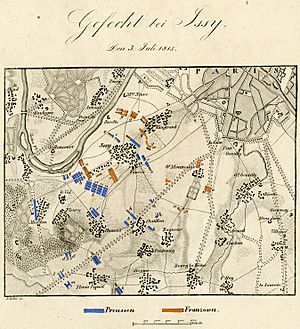Battle of Issy facts for kids
Quick facts for kids Battle of Issy |
|||||||
|---|---|---|---|---|---|---|---|
| Part of the Napoleonic Wars (Seventh Coalition 1815) | |||||||
 Plan of the battle of Issy 1815 (from 1837) |
|||||||
|
|||||||
| Belligerents | |||||||
| Commanders and leaders | |||||||
| Casualties and losses | |||||||
| unknown | 3,000+ casualties | ||||||
The Battle of Issy was a fight that happened on July 2 and 3, 1815. It took place in and around the village of Issy, which is just southwest of Paris. The battle ended with a victory for the Prussian General von Zieten. He defeated a French army led by General Dominique Vandamme.
Why the Battle Happened
After the French lost the Battle of Waterloo, the armies of the Duke of Wellington (British) and Field Marshal von Blücher (Prussian) marched towards Paris. These armies were part of the Seventh Coalition, a group of European countries fighting against Napoleon.
On June 30, Blücher's Prussian army made a smart move. They crossed the Seine river at Saint-Germain, below Paris. This put their entire force on the south side of the city. The French had not prepared their defenses well on this side. This was a big surprise for the French. Even though the British and Prussian armies were separated, the French could not stop them from joining up.
Later, Lazare Carnot, Napoleon's Minister of Internal Affairs, said that Napoleon should have fortified Paris better on its south side. Because of this, the French had to move their army across the Seine to face the Prussians.
On the morning of July 2, the Prussian I Corps, led by General Graf von Zieten, was ready to attack.
The First Attack
On July 2, Zieten's Prussian troops moved forward. They attacked the high ground at Meudon and Châtillon. They also fought hard to take control of Sèvres, Moulineaux, and Issy. The fighting was tough, but the Prussians eventually won. They managed to secure their positions on the heights of Meudon and in the village of Issy. The French army lost about 3,000 soldiers in this fight.
The French Fight Back
During the night of July 2/3, French leaders met in Paris. They decided that defending the capital against two large Coalition armies would be very difficult. However, the French Commander-in-Chief, Marshal Davout, wanted to try one more attack.
At 3 AM on July 3, General Vandamme led the French III Corps to attack Issy. They moved in two columns from Vaugirard. They had many cavalry soldiers and a strong battery of cannons near Auteuil. The battle started with a lot of cannon fire. The French used twenty cannons against the front of Issy village. Their infantry then attacked fiercely.
The Prussians had built some barricades during the night. But these did not fully protect them from the French cannon fire. Prussian regiments, like the 12th and 24th, fought bravely. Both sides suffered many losses. The French pulled back for a short time, but then attacked again with more soldiers.
General Zieten asked for more support from other Prussian corps. He also asked General Thielemann to attack the French left side.
The French attacked Issy again, but they failed once more. There was heavy cannon fire and more assaults. But the French could not gain a clear advantage. They did not try a larger attack, probably fearing that if it failed, the Prussians could easily storm the suburbs of Paris. After four hours of trying to take Zieten's position without success, the French retreated back to Paris. Prussian skirmishers followed them closely.
What Happened Next
The Battle of Issy was the last time the French army tried to defend Paris. After this defeat, all hope of holding the city was gone. The French commanders decided to surrender.
At 7 AM, the French stopped fighting. Brigadier General Revest, a French staff officer, went to Zieten's Prussian Corps. This was the closest Coalition force to Paris. He offered to surrender and asked for a ceasefire right away.
When Blücher heard about the French ceasefire, he demanded that French leaders with full power to negotiate meet him. He chose the Palace of St. Cloud as the meeting place. He then moved his headquarters there.
Officers from both sides met at St. Cloud. The Duke of Wellington also joined Prince Blücher. They discussed the terms, and the result was the surrender of Paris. This agreement was called the Convention of St. Cloud.
Napoleon Bonaparte had already given up his power on June 24, 1815. He could not stay in France or escape. A few days later, on July 15, he surrendered to Captain Maitland of HMS Bellerophon. He was taken to England. After Napoleon left, Louis XVIII became the King of France again. Napoleon was later imprisoned on the island of Saint Helena, where he died in May 1821.
See also

